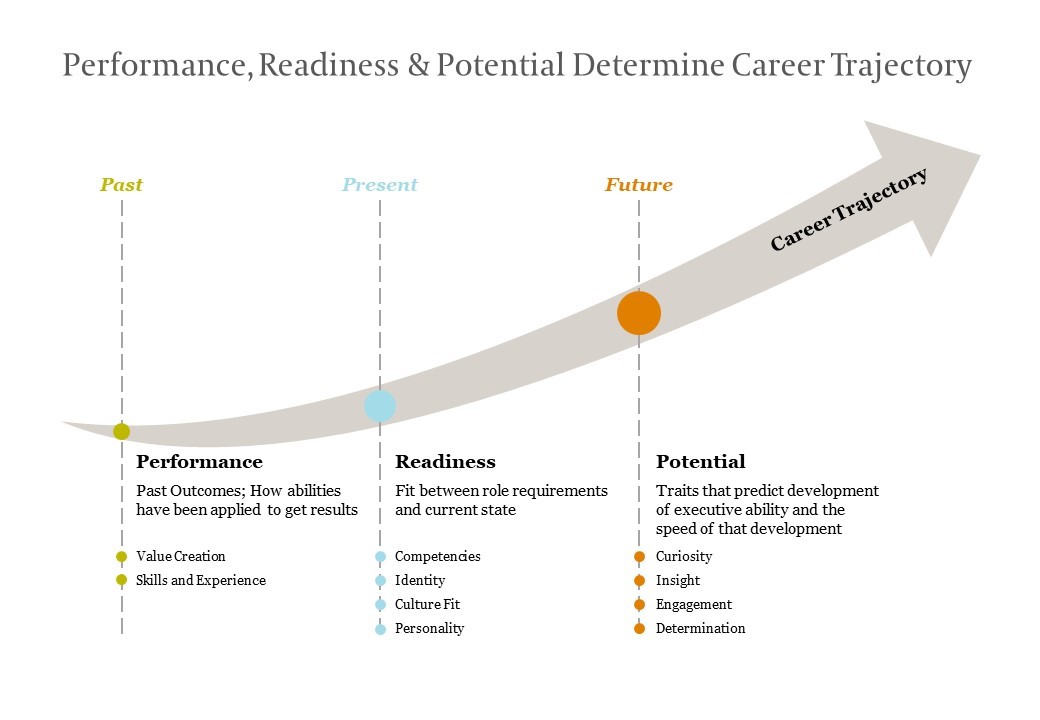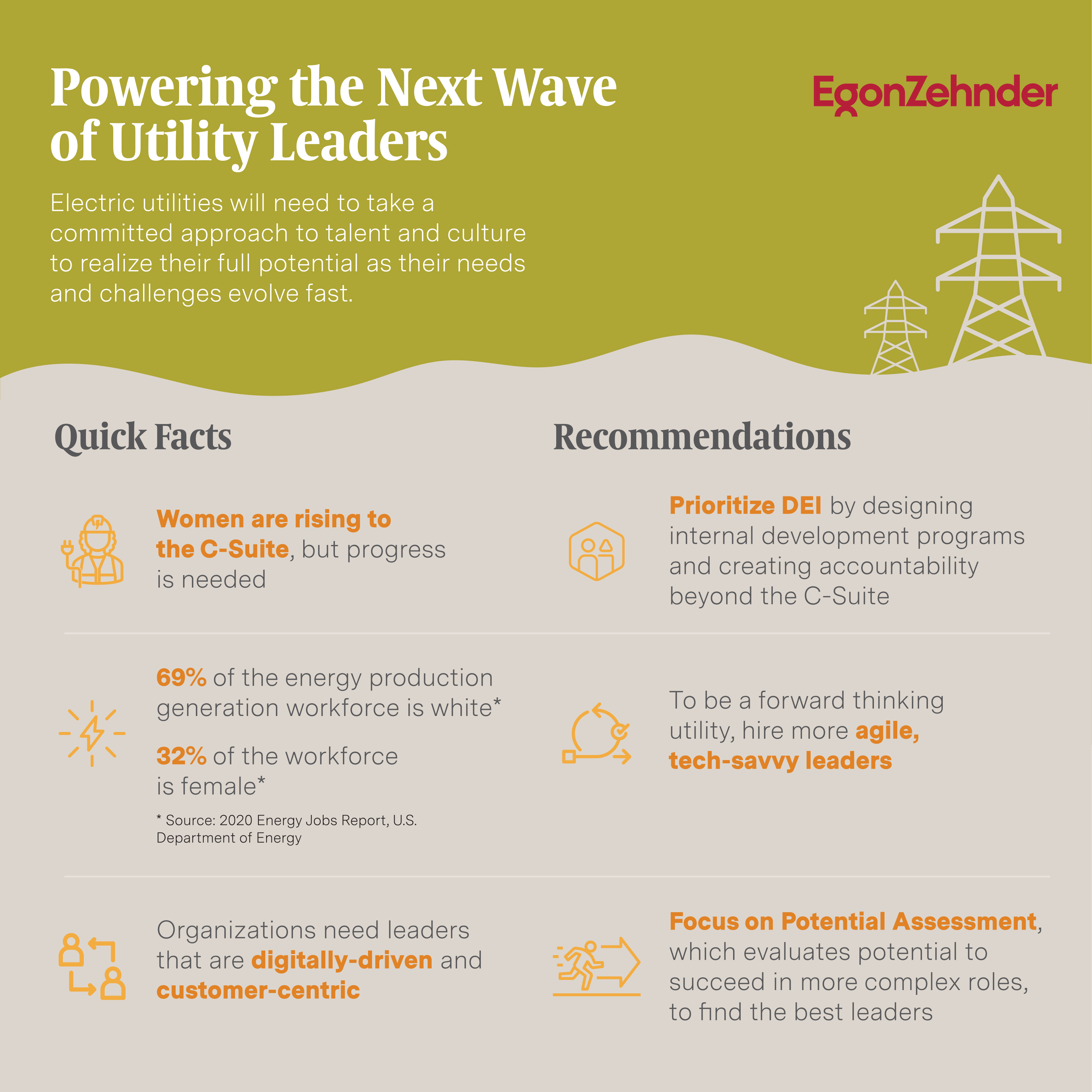The U.S. energy infrastructure has reached a tipping point with the recent enactment of the $1.2 trillion Infrastructure Investment and Jobs Act. While electric utilities are already investing more than $120 billion annually in grid improvements, this additional funding is a significant opportunity to accelerate the transition to a smarter, cleaner, and more secure grid.
To meet the challenge and achieve the promise of grid transformation, utilities will also need to look deep into their own organizations and cultures. Applying a human capital lens to grid transformation, the utility of the future will require a focus on agile leadership, the hiring and retention of leaders from broader and more diverse industry backgrounds, and a workforce culture that embraces diversity, equity, and inclusion.
Fostering a culture of Diversity, Equity, and Inclusion
Across every industry, the talent shortage is a top concern as workers resign at unprecedented levels and the need for new skills emerge. Added to these challenges, more than a quarter of all infrastructure workers in the U.S. are projected to retire or permanently leave their positions over the next decade. And because utilities deliver an essential service, it is critical for the utility workforce to more closely resemble the communities they serve. How can the industry retain and attract workers while ensuring a culture that values diversity, equity, and inclusion (DEI)?
Fortunately, there are signs of progress: One just has to observe the number of EEI member utilities with female CEOs. The story is different, however, two to three levels down from the CEO. Overall, 69 percent of the energy generation workforce is white, and 32 percent is female, according to the 2020 Energy Jobs Report. Diversity initiatives have gained momentum in recent years with businesses increasingly recognizing them as a strategic priority. Rightfully so—a culture of DEI, where everyone feels acknowledged and valued, can generate positive outcomes across the organization, such as psychological safety and a greater sense of ownership of the work.
While there is no defined playbook for building a strong DEI culture, there are two foundational elements: 1) allowing people to feel authentic and empowered to share different perspectives; and 2) ensuring staff from diverse backgrounds see a clear path for career advancement. Allowing people to maintain their authenticity, while also promoting a cohesive and collaborative environment, is a challenging balance that utilities will have to face. A good place to start could be by re-evaluating internal development programs, and establishing metrics and accountability systems to shape a culture of diversity. Transformation stems from the top, so leaders need to make an honest assessment of their organization’s current actions, purpose and strategy, and ask the right questions to make thoughtful progress.
Developing a Talent Pipeline to Power the Energy Transition
Utility leaders have long faced the complex demands of keeping pace with ever-evolving technology, all while operating reliably and cost-effectively to serve customers. However, as with all things technology-driven, the pace of change will only continue to accelerate. From building and integrating lower-carbon, decentralized energy resources and EV infrastructure, to mitigating cybersecurity risks and leveraging big data and artificial intelligence—the challenges and opportunities are immense. Forward-thinking utilities will require their leaders to be more agile and ready to steer the organization in a digital and more customer-centric direction.
But finding a leader who is the right fit is easier said than done. Digitally native talent is in high demand, and we are hearing from utility leaders just how hard it is to recruit and retain industrial talent. Additionally, while utilities have been doing a better job of recruiting more diverse workforces, it has still been a challenge to retain, cultivate and promote this talent into more senior roles.
So how can utilities effectively retain and promote a more diverse and broader talent pool while ensuring the leaders of the future are prepared to lead the energy transition? We believe it is important to place a stronger focus on individual potential, alongside experience and competencies—way beyond simply looking at a candidate’s resume. When executed properly, potential assessment is an invaluable tool utilities can leverage for identifying and developing a competitive talent pool that could otherwise get overlooked.
As a rule, we humans like to stick with the familiar. We talk about finding a ‘good fit’ between the organization and the individual. In many cases, that is code for hiring a person who represents the comfortable and the familiar. Certainly, familiarity can bring stability to any community. But it can also lead to myopia.
Claudio Fernández-Aráoz, retired Egon Zehnder Consultant and author of the book “Great People Decisions”
Egon Zehnder has developed a framework to guide organizations in assessing talent, the Potential Model. It offers a holistic approach that looks beyond candidate experience and evaluates potential to succeed in larger, more complex roles. It considers four key dimensions for assessing individuals:
1. Curiosity: Leaders who display this trait typically seek new experiences, ideas, and knowledge in a proactive way. They seek feedback and change behaviors in response, and are energized by change, experimentation, and feedback.
2. Insight: These individuals synthesize a vast range of data and use it to shape insights that make sense of ambiguity, simplify complexity, and break the status quo.
3. Engagement: Typically, highly engaged individuals connect with people because they feel a resonance with their motivations, priorities and logic. Their enthusiasm, energy and sense of purpose are infectious as they can engage the hearts and minds of others to deliver shared objectives and mutual benefits.
4. Determination: These leaders enjoy a challenge, overcome obstacles, and willingly take on higher risk opportunities with ingenuity and tenacity. They possess the self-discipline to stay with the challenge. However, they don’t let strength of purpose descend into mere stubbornness.

Utilities are now at a tipping point with the move toward decarbonization, decentralization and digitalization. Leveraging this opportunity and preparing for future growth requires that today’s leaders make informed talent decisions for the utility of tomorrow. As the figure above illustrates, part of the solution is to assess talent by looking at the past, present, and future potential to predict an individual’s career trajectory. Traditional “high” versus “low” potential assessments are not enough for assertive talent decisions. Simply put, when done right, potential assessment can mean the difference between those utilities that successfully navigate the energy transition and those that stumble.
Generating Lasting Impact
There will never be a better time to plan for future challenges and opportunities than now. What kind of industry do leaders want to shape? Whatever the answer may be, it will start by propelling a new wave of capable and agile leaders and fostering an internal culture that motivates and develops its workforce. Taken together, these measures will be the differentiation factor for utilities to not only respond to unpredictable challenges and disruptions but to lead the energy transformation and generate long lasting impact.






